March 2004
That’s What We Love About the South
Louisiana, Mississippi, Alabama
Or… In the spring, a young man’s (and a middle-aged couple’s) fancy turns to the Deep South.
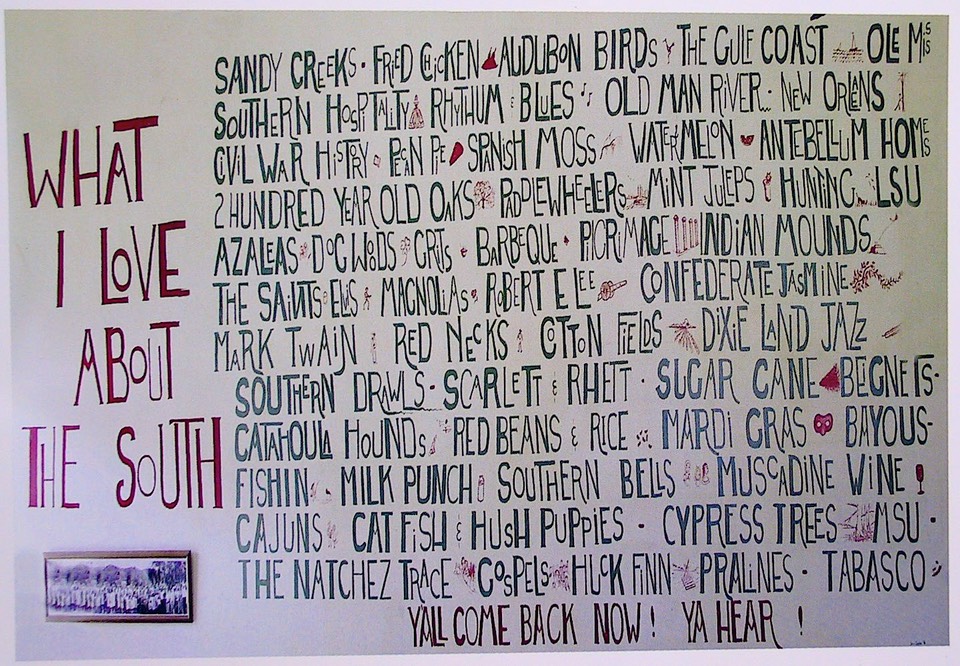
And springtime in the land of dogwood and azaleas and redbud and wisteria……..? No surprises: it really is lovely; if the south stayed like this year-round, we sure would hang around here more. Coming out of Texas around the first of March, we made a deliberate decision to see what pleasures the south had to offer, and we haven’t come up short.
In the past, Louisiana, Mississippi and Alabama have, for us, largely meant the stretch of I-10 that quickly whips you through the southern edges of these states; we wanted to see what else was out there. We bounced back and forth some, wanting to attend certain events, and we are now having an out-of-area experience traveling up through Tennessee to Kentucky, visiting old buddies Tom and Pat Wardell, recently removed from Arroyo Grande to Louisville; otherwise we stayed “down deep.”
On earlier trips, Louisiana is a state we have tried to like, without much success. So we figured, “Let’s start with Louisiana, and give it every chance to show its best side.” The state’s roads aren’t very good, which has always put us off; and that didn’t change much. Other poor regions have been putting money into their highways (Mississippi is a very good example), but Louisiana seems to have other priorities. Wherever we traveled, we were always muttering (and Agnes was hollering) about the bumpiness.
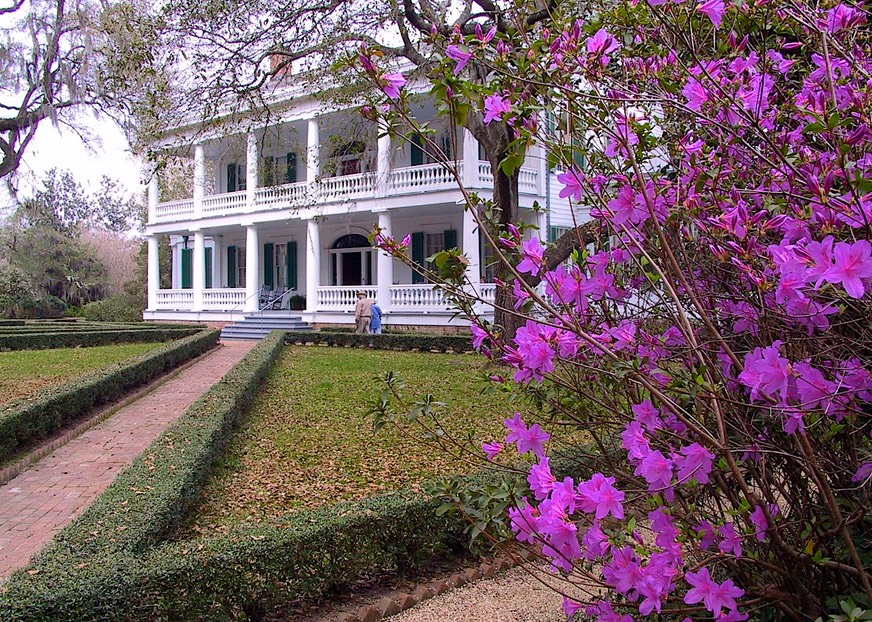
We started our stay by circling around New Orleans, and ended it in the city. We had a lovely visit to the St. Francisville area, north of New Orleans. This is the area of the Feliciana Parishes, with nice country roads and small, old towns pretty much left alone since cotton days. This is a backwater area of the Mississippi River. Back in the early 1800s, it was very rich plantation country. We stopped and visited Rosedown Plantation, a special treat. This property is unusual in that it was kept in the family until the last sister passed away in the mid 1950s, and it still has most of the original furnishings (including unused wool carpeting in the attic off the same roll that was still on the floors – over 150 years old). Mid-century, the family sold the property to a very rich Houston oil widow who lovingly and thoroughly restored it, including finding the company in Paris (still going strong) that had made the wallpaper in 1830. They didn’t have any of the original paper left (!), but had something very similar from that same time period, and that’s what you see on the walls today – 18” squares of silk wall paper. The home just came to the State in 2000 and is in beautiful condition. The wife of the original planter was a leading figure in developing formal gardens in the US in the 1840 to 1860 period, and the grounds for this property were very nice; the afternoon we visited, two different brides were having their pre-nuptial portraits taken in the gardens. We really enjoyed ourselves here; it was all we could have hoped for. We tend to approach such experiences with trepidation; neither of us likes costumed guides speaking “in dialect” and overwhelming us with trivia, and huge gift shops with useless junk for sale; this was much better quality than that.
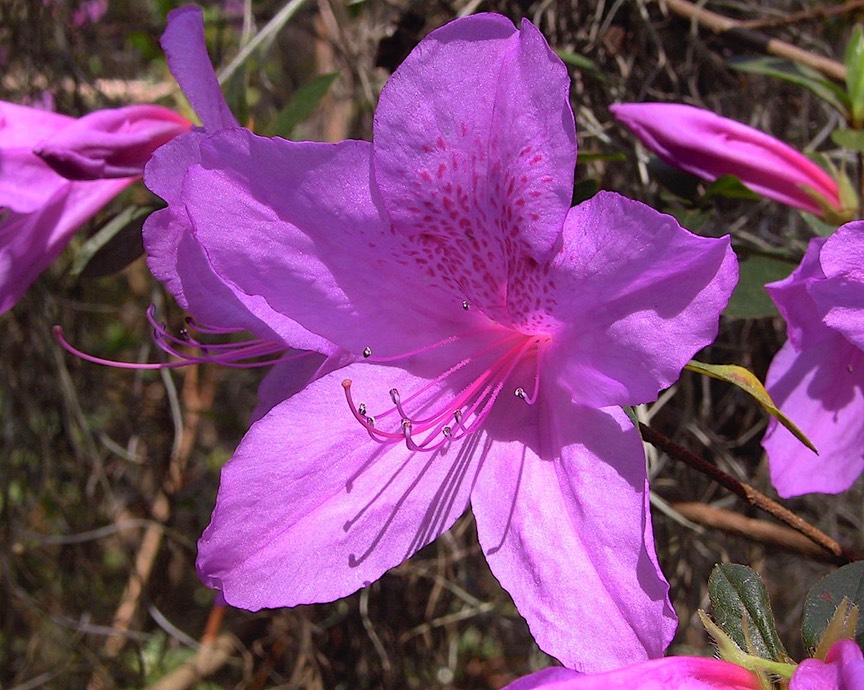
Continuing along the River, we spent a little time in Baton Rouge. That’s all it really takes; Baton Rouge doesn’t have a lot going on, although it’s the state capital and the home of LSU. We visited the capital building, which is really beautiful, discussed the man who got it built – Huey Long – and promptly went out and bought a copy of Robert Penn Warren’s All the King’s Men. That book is a joy to read, if you haven’t picked it up since college days; Warren was a gifted writer. Pulitzer people seemed to think so, too.
We headed down towards New Orleans, hugging the river, passing through sugar cane country and several plantations along the way. The weather reports indicated bad stuff ahead for the next couple of days, so we decided to hang out in a campground until the skies cleared. We’d heard good things about a state park on the edge of the Atchafalaya Swamp and decided to check it out. Totally cool, very exotic and fun, except that dummies that we are, we didn’t think about the mosquitoes. Sitting out two days of warm rain in a swamp? You can just imagine. But it was fun anyway; we saw cool turtles and an alligator, and an owl hung out in a tree right across the road. Dank and damp, but a kick none the less.
A word about traveling along the River: you cross it over and over and over again. Sometimes on big bridges, sometimes on teeny ferries. We did a couple of the latter and it was quite an experience. The locals are REALLY local. They sit in their junky old cars and drink during the crossing; the hunters have big dirty trucks with ATVs and caged dogs in back; it was really interesting. These ferries are family-run operations, and we’ve chatted with some really nice folks, but you do get a taste of real life. We passed many fields meant for sugar cane (they were dormant) and enormous oak trees that were all that was left of plantations, and tiny towns with old cemeteries (yes, the vaults were all above ground). And of course the River isn’t where it used to be. If you look at a map, you can see oxbows and isolated curves of water that are not connected to the course of the modern-day river. Gets really weird when you consider that the state boundaries were drawn to coincide with the path of the water; these days the River wiggles and not waggles, and has left parts of states high and dry on the wrong side of the river, but the boundaries have never been adjusted.
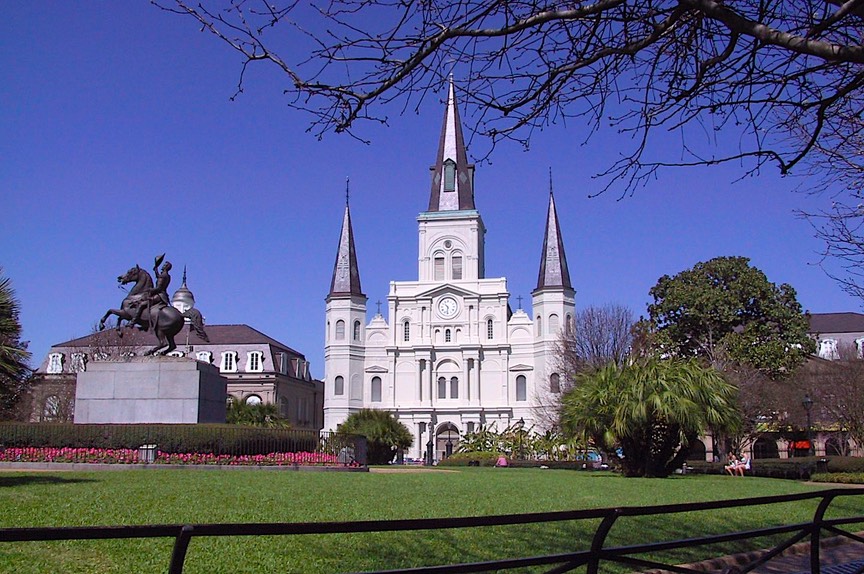
The rains stopped and we gathered ourselves for the onslaught on The Big Easy. We are very slow to decide to visit a big city: we don’t want to take our motorhome there (even as small as we are), and finding a spot for ourselves combined with public transportation can be difficult. We had heard about a state park that would have worked out pretty well, but in visiting it to check it out we were doubtful about the security of the motorcycle during the day. Should have gone ahead and done it anyway; we decided that later. But by then we’d already done a fair amount of wandering around through areas that were really terrible – reminiscent of West Oakland, East L.A., whatever your experience has been – and we weren’t pleased. So we decided to bite the (expensive) bullet and stay in a KOA campground in the outskirts of the city which advertised a shuttle bus to the French Quarter. And that worked out okay. KOAs are decidedly not our cup of tea, but it worked. And we spent a lovely, balmy, clear day in New Orleans that was delightful. The shuttle driver gave us the two-bit tour on the way in, so we saw a bunch of stuff we wouldn’t have caught otherwise, and he was fun. We wandered the French Quarter and had beignets at Cafe du Monde; went to Mother’s for lunch and had file gumbo; bought and promptly consumed some splendid pralines; and walked down to the D-Day Museum and spent an all-too-brief couple of hours there before they closed. But the best thing we did was to visit a recommended bookstore (the Faulkner Bookstore) off Jackson Square. An old, original French Quarter building, it had been the house where William Faulkner lived for a time in 1925 while writing his first novel. Now that was cool! Having broken through our reluctance to visit this splendid, historic area, we will hope to return to New Orleans again and spend more time; but this was enough for a first visit. (unfortunately Katrina has intervened and these plans have been put on hold, ed.)
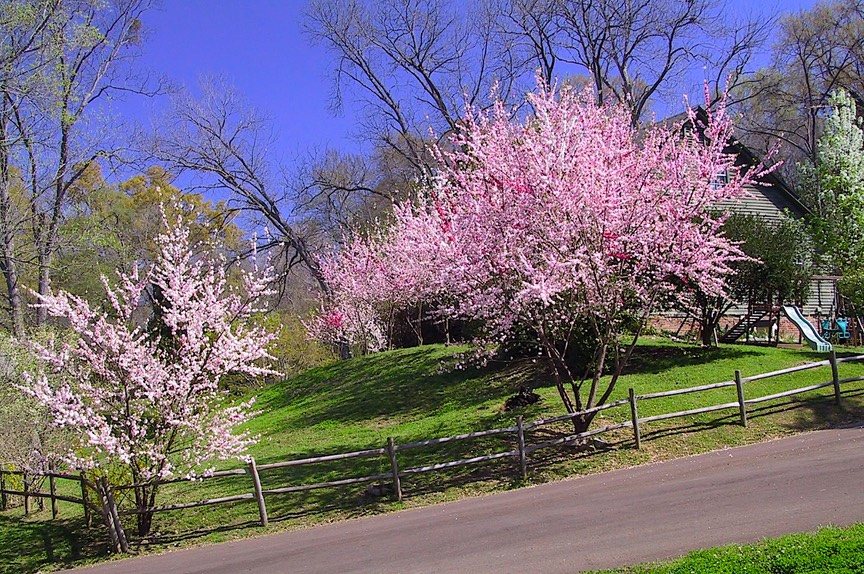
We briefly considered heading up to Natchitoches, Louisiana, an area we very much would like to explore, but decided the great state of Mississippi was calling us. So we headed over to the Natchez Trace instead.
Mississippi is lovely right now. We’ve spent most of two weeks wandering amongst the dogwoods and red bud, the wisteria (incredible this year; they say it’s taking over the south and is the new kudzu), the forests in the northern half of the state, along pretty, well kept roads and in-and-out of nice small towns. Mississippi seems more prosperous than Louisiana; its roads are in better shape, we’ve seen fewer areas of real poverty, and the “jes plain folks” seem to be doing fine. And they sure make us feel welcome: I love being called “Sweet Pea” and “Sugar”; you get the picture. What we have seen, however, that worries us, is the great dependence upon tourism to sustain many of the towns. In our visits to Natchez, Vicksburg, Port Gibson, and other well known spots along the River, it’s apparent that if folks don’t come and see their historic homes and attend their festivals, and play at their casinos, not much is going on. It’s a vast, vast oversimplification to say that it’s an unhealthy economy, but if I were in charge, I’d be looking to diversify! Prior to the Civil War (or The War Between the States, as it’s often referred to down here – at least we’ve stopped seeing it called The War of Northern Aggression), Mississippi was the fifth wealthiest state in the union and home to fully one half of all the millionaires in the country – all based on slavery and the cotton trade of course. Its greatest wealth was centered along the Mississippi River; the modern state is so different.
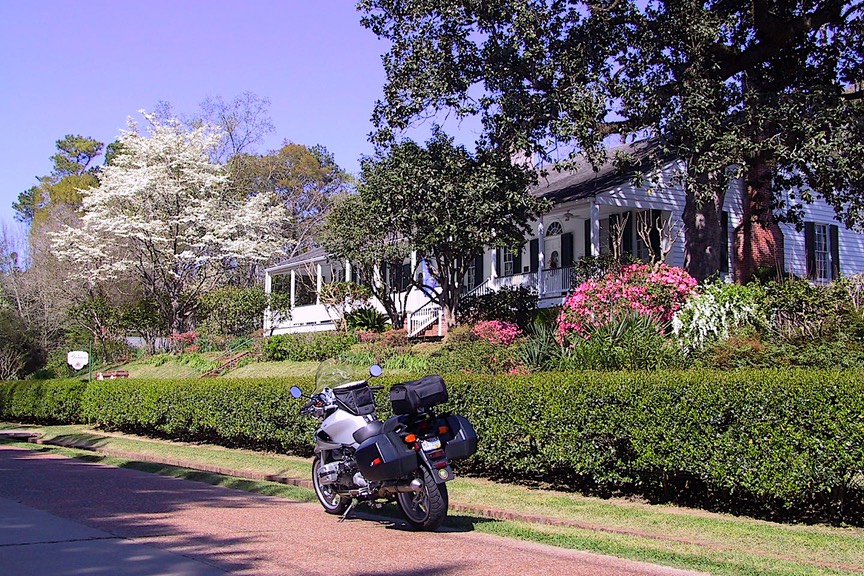
While in the state we’ve spent a goodly amount of time exploring the area along the river. Natchez is a town famous for its antebellum homes and historic atmosphere. We arrived at the beginning of Pilgrimage season, and there was lots of activity. We had a great lunch at the Pig Out Inn (“Swine Dining at its Finest”), where we discovered the wall you see replicated above. “’What I Love About the South” is painted all over one end of this little lunch joint. The food was yummy, too. We wandered around town while Rick did his best to fulfill my yen for the perfect dogwood tree picture, visited the national cemetery there, checked out the Visitor’s Center (where a very earnest lady was absolutely incensed that I didn’t want her brochure on the Pilgrimages – “you are the second one this week”). Natchez sits on a bluff, and there are lovely views of the river; a pretty town to visit, but they were disturbingly anxious about our need to spend money there. Pilgrimages are expensive, and we don’t like being herded along seeing stuff, and had decided to skip the whole deal.
Escaping town, we meandered up the Natchez Trace to Port Gibson and the Grand Gulf Military Monument Park. If you’ve never traveled the Trace, it is indeed a lovely ride. Structured similarly to the Blue Ridge Parkway, there is no commercial activity or signage its entire length, few homes, small amounts of agricultural development, and plenty of peaceful scenery. Moving north from Natchez, we visited Port Gibson, historically significant during the Civil War and full of lovely old homes (having been left intact by Grant, rather than being burned to the ground) and stopped nearby at Grand Gulf. This was a truly delightful spot.
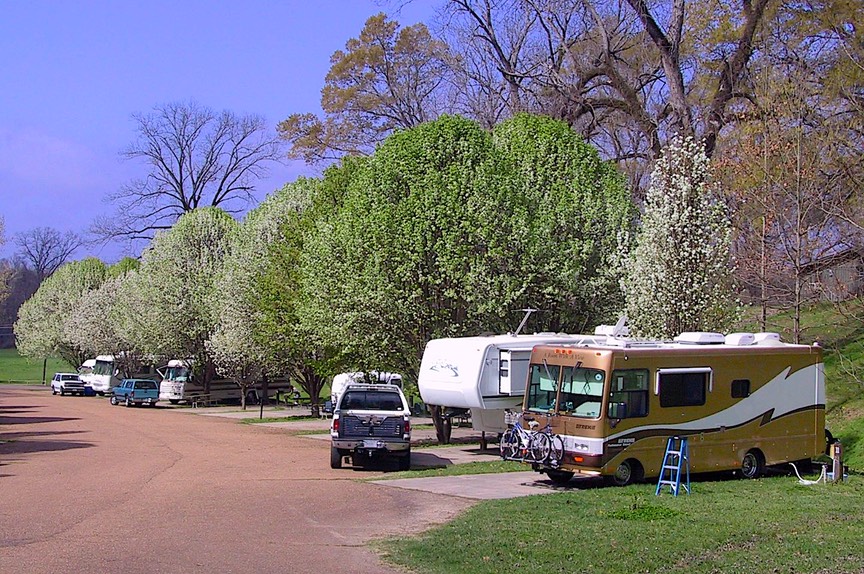
We arrived just as many trees were coming into bloom, and ended up staying an entire week. The park is near where Grant crossed the Mississippi (doing an end run south of Vicksburg, he came ashore here, subdued the locals, went east to destroy Jackson, and then turned west and attacked, and then besieged, Vicksburg; one of the great, celebrated campaigns of the war). Anyway… Grand Gulf used to be a town. It was destroyed by the overflowing river, yellow fever, Grant, and by time itself. There’s not much left except a beautiful park and campground, a few cannon, and a lovely restored church that’s worth the price of admission all by itself. While we were there, a couple of “re-enactors” were camping out, and occasionally we’d hear a cannon going off. Oh, and gosh, don’t forget we had BBQ at Pakky’s in Port Gibson. The sign said “sidewalk café,” but there was no sidewalk in that part of town… but the BBQ was super! While we were camping at Grand Gulf, we had a great visit with some buddies heading home to Florida after spending a couple of months in Mexico. We caught up on the news, giggled a lot, and they moved on.
Woodrow’s Butt Paste – “It’s not just for rashes” – sign somewhere along the way – honest, we don’t make these things up.
We touched base in Vicksburg, which we had visited before; unfortunately it shares a problem with many other medium-sized towns: what to do to keep people coming, but save your old streets and “charm.” Vicksburg needs to work harder. They have several roads sort of circling the area, all with shopping malls or attractions (universally ugly), and it’s hard to have a quality experience. A very important battle took place there (see above), but it is not one our favorite civil war sites. The park was laid out around 1900 along the confederate and union lines from during the siege but we find the available information to be sketchy and not very well presented. The national cemetery there was, however, lovely and a delightful place to visit, and a newly completed museum dedicated to the river gun boats of the war looked very nice. We moved on.
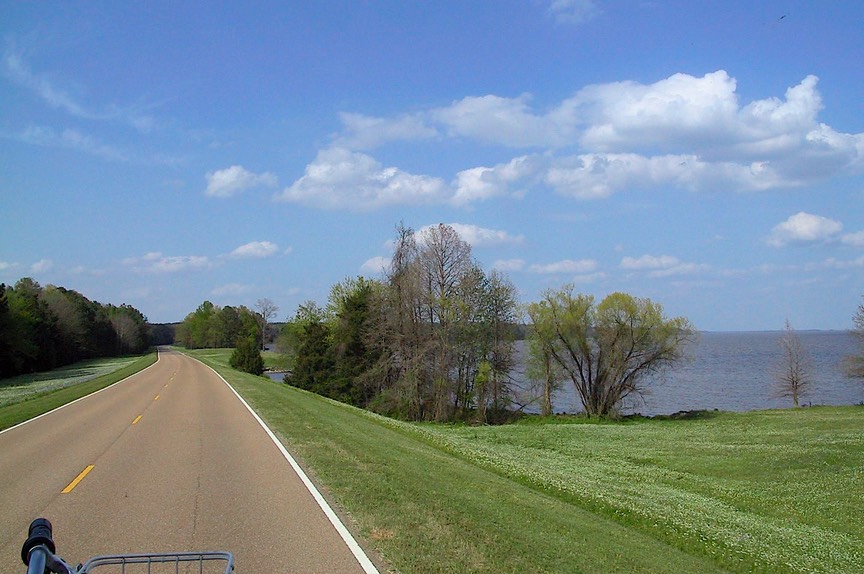
Jackson is the capital of Mississippi; the new capital building was constructed in about 1903 and is historic itself, but we satisfied ourselves by visiting the museum that has been made out of the “old” capital, built in the 1830s. it was a grand old building with good displays, and worth a visit. There we saw, in a history of the state, what was annotated as the earliest display in history discussing the civil rights movement in the South. It was surprisingly straightforward, with newspapers and film footage that clearly showed blacks being manhandled, photos that still make us uncomfortable; Mississippi isn’t dodging its responsibility here. I have a southern branch of my family, and Miss America of 1957 (Mary Ann Mobley, even if you don’t care) was my cousin. I was invited to come south and attend Ole Miss when I was considering schools (UC Davis won out quite easily, of course); I wouldn’t have lasted 6 months down here.
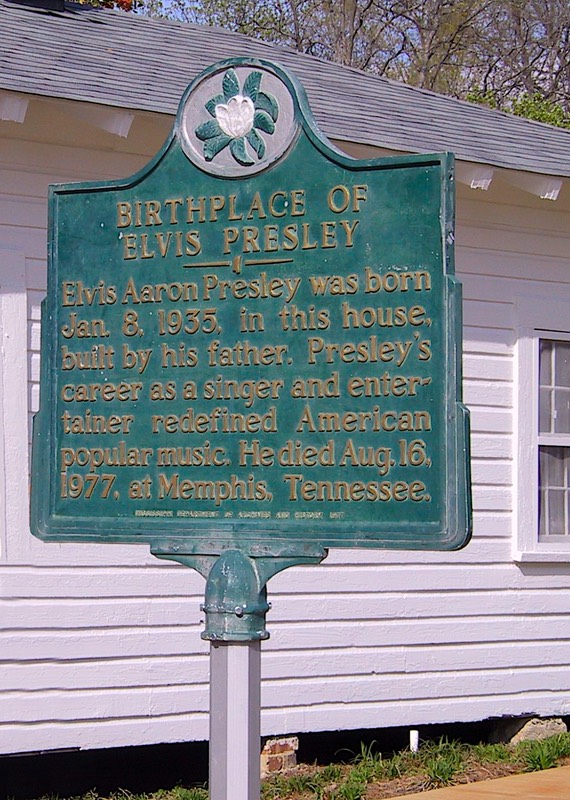
No visit to Mississippi is complete without a trip up to Tupelo. Why Tupelo, you ask? Silly! That’s where Elvis was born! They say 50,000 people visit this burg every year, just as part of their pilgrimage. It’s sort of on the way to Memphis. Well, we weren’t going to, but one afternoon Rick took a quick left and we parked in front of the house (“the most important house in the world” to the faithful), beside a memorial, and a statue of Elvis at the age of 13, complete with guitar in hand. There’s a self-guided tour you can take, that includes his elementary and middle schools, the drive-in where he hung out eating “cheeseburgers and RC Cola,” “the library… where Elvis got his first library card”… etc… heard enough?. All rather revolting, I’d say, but amusing, none the less. Tupelo also has a nice historic automobile museum that we did visit and enjoy.
On our trek to Tupelo, we stopped off in the little burg of Sturgis (no, no, you silly; not the one in South Dakota; actually there are Sturgises -- Sturgi? Sturgesees? -- in eight different states – in case you were wondering) a tiny town complete with town hall that was two rooms and a couple of filing cabinets. One of those rooms is the court, complete with a table and a couple of stuffed chairs. Pretty relaxed, but the folks were great and gave us the directions we needed. Sturgis is the home of a nice little BMW motorcycle shop and museum we’d heard mentioned and Rick wanted to get a look. A fine time was had by all, and an hour later we were back on the road, riding through lovely wooded areas filled with flowers and forests. And did I mention the wisteria? Wow! This stuff is taking over; it not only grows as bushes, but it’s enveloping the trees. It’s in full bloom right now, and stunning, and did I mention fragrant? Awesome! Oh, and the crabapple trees are in bloom, too. More awesome. Oh, and about that duck harassing the cats in the picture. On our way to Sturgis, we spent the night in a lovely little Forest Service campground on Choctaw Lake, which had resident muscovy ducks. Pests, in fact. Overrun by them, according to some. Well, we only saw the one, obviously in charge, following us about and QUITE interested in the cats. Had them all a-twitter, I must say. The ranger begged us to take him with us when we left, but we decided we didn’t have room to carry duck food, so we declined. On to Sturgis!
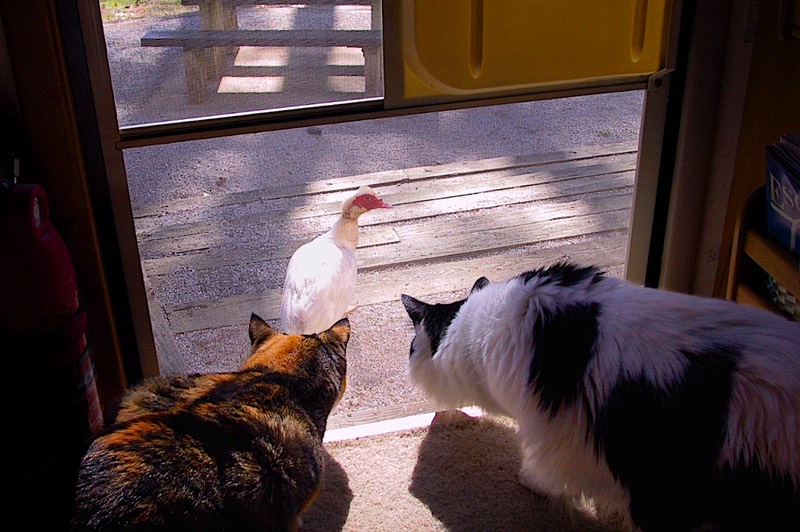
Abandoning Tupelo for better parts, we had promised ourselves a visit to Oxford, home to (the aforementioned) Ole Miss; also the prettiest courthouse square in the universe, a killer bookstore that’s in the first building constructed after the end of the Civil War, tons of lovely old homes, and Rowan Oaks, where William Faulkner lived and wrote. We fell in love with this town; about 15,000 people, still charming and quiet, full of ancient tree-lined streets; a delight. We could have stayed forever, but it was only a day trip on the motorcycle. As we were leaving, we had a from-another-dimension experience. We stopped for gas, asked the girl at the nearby pump for some directions on getting out of town, and got an earful. She is an English major at the college, had come here because it was such a special town; she kept insisting that the town had taken Faulkner’s body and had it bronzed after he died, and had set the body on a bench in front of the town hall where people could sit and talk to him. She swore it was true, and if false that three different professors were lying to her. Bizarre! But she was cute. Her boyfriend just kept looking at her and rolling his eyes.
Tupelo and Oxford are in the northeast corner of Mississippi, and we ducked over the border into Tennessee to visit Shiloh, a very favorite spot of ours. The site of a very bloody, nasty battle early in the Civil War, the area has been maintained as it appeared in 1862; this part of Tennessee is quite rural, too; in all, a real chance to visit the past without the intrusion of strip malls and fast food joints that afflict some other historical sites. It’s beautiful at Shiloh right now, with trees in bloom and just beginning to green up, very few people around, the cemetery well maintained; a great visit to a pretty spot. This corner of the world, the joining of Alabama, Tennessee and Mississippi, is lovely. The Tennessee River flows through here, it’s very rural, rolling forested hills and green countryside; quite delightful. We ducked back into Mississippi to visit Cornith, another old, old town that was important during the Civil War; then we hopped across another border into Alabama.
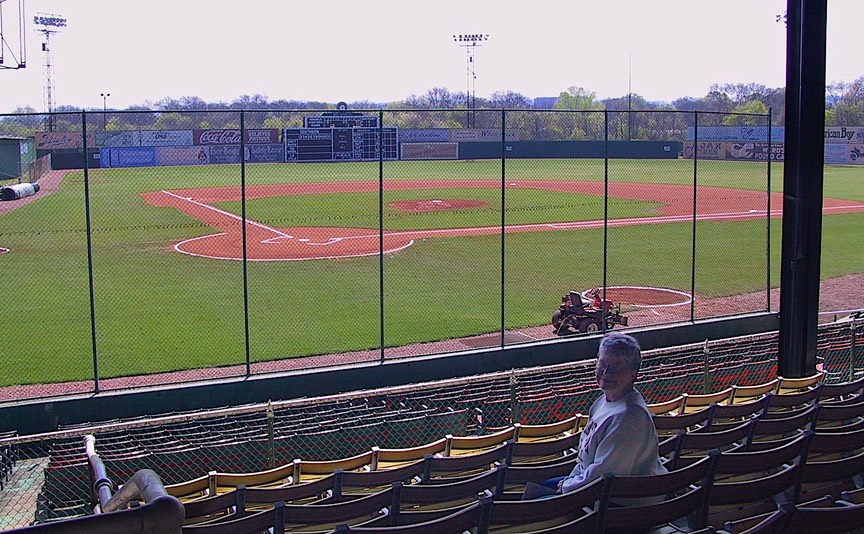
Why go to Alabama? Why not? Our tour of the deep South in the springtime needed a Tuscaloosa-Birmingham stop. Birmingham is a large city, and we will be back in May for some motorcycle races, so we contented ourselves with a visit to the (very nice) Museum of Art, which had a special exhibit on French baroque and French impressionist paintings. A good time was had by all. We also spent a nice hour at Rickwood Field, the oldest extant baseball field in the United States. It was built in 1910, and was the home of minor league and negro league teams including the Birmingham Black Barons, who won a league championship in 1948 featuring a then 16 year old outfielder named Willie Mays. Several years ago, a group formed a foundation in order to restore the site, and slowly they are returning it to its glory. It has continued to be used by local leagues, although it was abandoned by the local minor league team, the Barons, in the 1980s. What is so cool, though, is that it is wide open for a visit, the field is in beautiful condition, costs nothing, and you can walk out onto the diamond, stand on the pitcher’s mound, and see where Hank Aaron, Satchel Paige, Ty Cobb, Babe Ruth, all stood and played.
We swung through Tuscaloosa to visit the University of Alabama. We have a new daughter-in-law who went to school there, so we, of course, took pictures of ourselves standing in front of welcome signs, waving frantically (the passersby must of thought we were nuts – perceptive folks all), which we subsequently mailed off to her. Go Bama! Near Tuscaloosa is the Mercedes Benz factory with visitor center and museum; it was a cool joint, even if they didn’t have any of the old racing cars Rick was looking forward to drooling over. A lovely spot, and they take good care of their visitors.
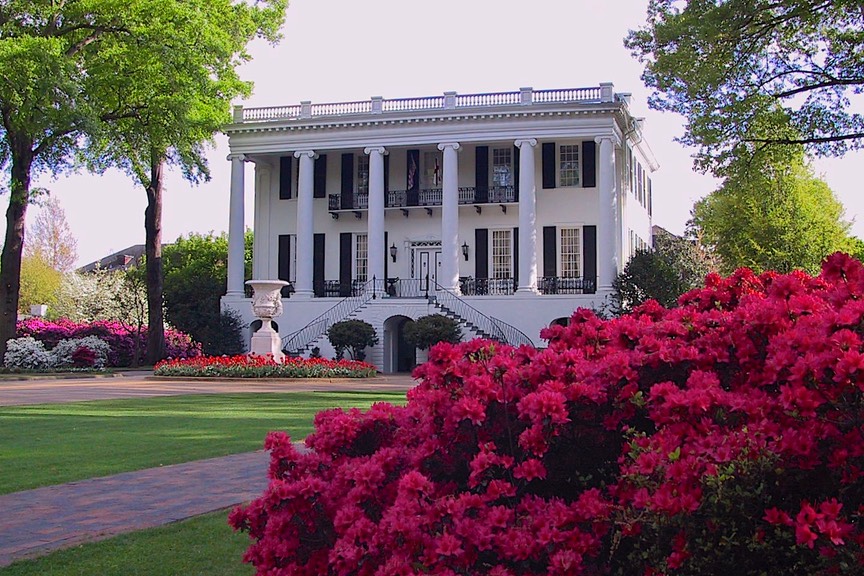
Then we trekked back into Mississippi, which was just fine with us; we were on our way to a motorcycle rally outside Vicksburg, and it was a great three days. We were camped in a small, isolated rural area not far outside town, which was truly lovely (although Rick never did get motivated to take any pictures), complete with pond, ducks and geese everywhere, the family (one) deer, horses, etc., very relaxed group, southern BMW riders, with good food and music; we made some new friends and had a swell time.
Our time in Mississippi was drawing to a close. We started swinging north to head up into Tennessee and eventually Kentucky. But first we wanted to investigate the Mississippi Delta, home of cotton, catfish and the blues (at least that’s what each and every brochure on the area tells us). Well, it’s a mixed bag. As you move north along the River from Vicksburg, the countryside begins to flatten out (the delta). Lots of fields waiting to be planted, lots of catfish ponds (some being harvested), and not much else. We stayed overnight in a small park right on the River, one of the few spots where there isn’t an enormous levee between you and the water. It was pretty, and we enjoyed watching the barge traffic going up and down day and night.
We visited Leland, the home of Jim Hensen, because there’s a Kermit museum there… but it was closed. We went through the town of Hushpuckena, but didn’t even notice it. You can see we weren’t overly impressed. Our major goal for the morning was to visit Clarksdale and check out the Delta Blues Museum. This is big time blues country. But we were stymied. Clarksdale is a really, really old town. As you come into town, you have to go under a train overpass; there was a huge sign saying 11’ 6”; wellllllll, we’re about 11’ 2’; and that’s toooooo close. So we paralleled the train tracks until we could find a crossing, and headed back into the “downtown” area. But circle though we might, we never found another sign to the museum, and ended up out in the countryside again. Maybe we’ll try another time. And for you cognoscenti, no Morgan Freeman to be found. Frump.
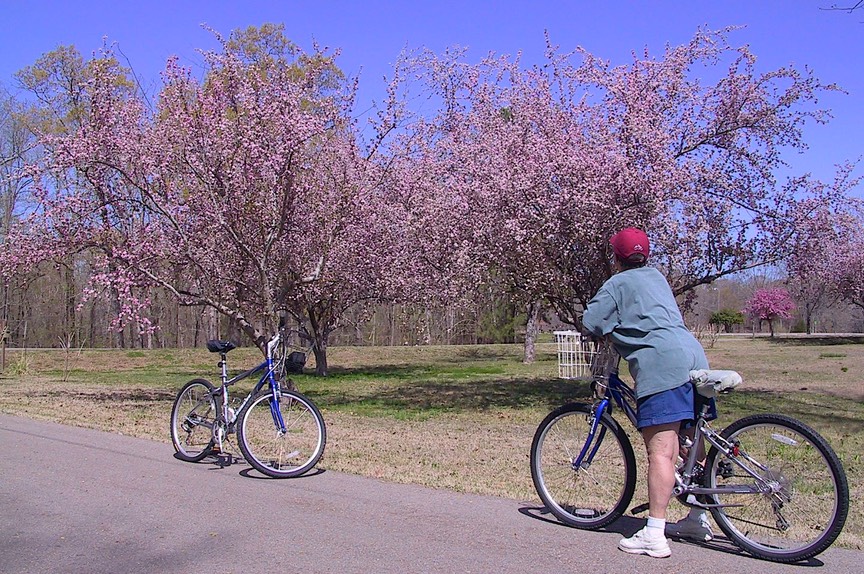
Sign along the road advertising a herbicide: “Root not, Nematodes!” And a real estate company called Krye-Leike Realty (as in the song Cry Like A R…); now don’t you think they could have changed that to a better name?
We were feeling a sense of urgency anyway. A hose on the chassis air conditioning had failed, and we were on our way to a repair shop that, hopefully, could solve the problem for us. This would in time bring us across Tennessee, seeing more of this favorite state than we would have otherwise, so no ill feelings to be found. So we leave you here, dear readers, knowing that “Springtime in the South” is indeed a worthy goal. It was delightful, full of lovely flora and countryside, beautiful homes, gracious folks who are happy to make your acquaintance; everything you could wish for. And the hush puppies are delicious.
Happy Spring to all of you. Let us know what you’re up to, what plans you’ve made for this year, and if we might be able to get together. And a special question to the “Why Things Are” guy: why is red bud purple?
Rick and Kathy and the shedding kittycats
P.S. The butter is back in the fridge; the extra blanket has been put away, gotten out again and put away once more; and our faithful little catalytic heater the same. It’s spring and the only thing for sure is the weather it is a changin’.
See more photos from the US in 2004